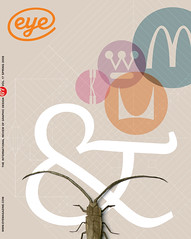Spring 2008
Portrait of the designer as author
Chip Kidd, designer and now novelist, is as skilled at crafting his own image as he is at creating other authors’ book covers. Critique by Rick Poynor

While designers sometimes get their pictures taken when they appear in magazines, they are rarely the subject of photographic portraiture in any more formal sense. Only a few graphic designers – Tibor Kalman, Stefan Sagmeister, who else? – have played around with their own image in a deliberate and entirely comfortable way, and it’s probably no coincidence that they are, or were, American (Sagmeister by adoption). Unembarrassed, full-on self-promotion is as natural to Americans as mom’s apple pie.
Add to that list Chip Kidd, who might just be the most celebrity-hungry image builder of them all. For Kidd is an author, a literary figure as well as a designer, whose second novel, The Learners – previously serialised in USA Today – came out in the US in February. With his position as in-house designer at Knopf, a wide circle of literary acquaintances – in Chip Kidd: Book One (see the review in Eye no. 60 vol. 15) he fools around in a photobooth with his pal Donna Tartt – and a partner, J. D. McClatchy, who is a renowned editor, literary critic and poet, Kidd is seriously well connected. How many other designers would have the nerve to ask John Updike if he would care to supply an encomium for their design monograph? And how many would Updike be delighted to oblige?
Now genuine, New York Times Book Review, Barnes & Noble front window authors really do need a proper author photo, so Kidd, who has handled a few in his time, turned to one of the best in the business, Marion Ettlinger, whose list of notable subjects includes Truman Capote, Tom Wolfe, Raymond Carver, Patricia Highsmith, James Ellroy, Richard Ford, Jonathan Safran Foer, and too many others to mention. The shot they produced together featured in Ettlinger’s book Author Photo (2003) and it surfaced again recently on Design Observer, where it was paired with a similar portrait of the actor Edward Norton. Kidd looked way more glamorous.
He commissioned the picture himself and seems to have settled the bill. ‘I think I paid for my author photo,’ he told the literary journalist Robert Birnbaum. You would think he’d remember a detail like that, but Kidd doesn’t like to look like he is trying too hard, even when he is, as in this case. He is equally dismissive about his pose in the picture. It was just ‘something we did as a goof’, he says. ‘I was trying to look butch.’
This curiously anachronistic image might have been taken 80 years ago. It was about then that Kidd’s round Windsor eyeglasses decorated with tortoise shell Zylonite (an early plastic) went out of fashion. James Joyce wore a similar pair; today, the look is kept alive by Harry Potter. Kidd’s hair is equally retro: its carefully controlled shape might have been styled with a comb using a 1920s pomade. But it’s the manly white sleeveless vest exposing his chest hair that sends the most incongruous signal. The Ivy League elements of his facial appearance aside, Kidd looks like a hard-working guy out of a John Steinbeck novel or a painting by Ben Shahn, taking a break from his labours pounding – what? A manual typewriter? Ettlinger shoots in black and white, on 35mm, using natural light, and many of her pictures recall portraits from earlier decades. There is rarely much background detail to fix them in the present. She makes her own prints in the darkroom, burnishing the highlights to achieve a satisfying physicality of contrast. The gleam accentuates the muscular bulge of Kidd’s shoulder and draws attention to the long line of his noble, determined nose.
Kidd’s pose, leaning forward on his knees, compresses his trunk, pushing his arm towards us and making his head as big as possible relative to the space occupied by the rest of his body. The cigarette, central to the period effect and a pretext for modelling the arm, is only a prop, as he confessed – he doesn’t actually smoke. Yet in spite of the play-acting, something of Kidd seems to come through. There is a hint of wariness in the pose’s intimacy and perhaps some vulnerability. (Why the need, after all, for the stream of deflective wit that greets his interviewers?) In other circumstances, a figure sitting like this might express weary resignation in defeat.
His latest photo, on the dust jacket of The Learners, is almost a throwaway. Our author wears rimless glasses, a few days’ stubble and a rueful expression. To put some zing in a dull picture, Chip cleavers it in two so you get half on the front flap and half on the back. He wants a bigger stage now. He has a ‘new wave’ band, Artbreak, with a MySpace Music page. But his catchy vocal phrasings pale beside the bizarre thespian ‘experiments in form and content’ with which he promoted his novel on YouTube. Chip Kidd as Hollywood character actor Peter Lorre wheezing out the words of Sheena Easton’s ‘My Sugar Walls’ is a ghastly image. Here’s a graphic design star pulling out all the stops for a piece of genuine stardom. He might even get it.
Rick Poynor, writer, founder of Eye, London
First published in Eye no. 67 vol. 17 2008
Eye is the world’s most beautiful and collectable graphic design journal, published quarterly for professional designers, students and anyone interested in critical, informed writing about graphic design and visual culture. It is available from all good design bookshops and online at the Eye shop, where you can buy subscriptions and single issues.

